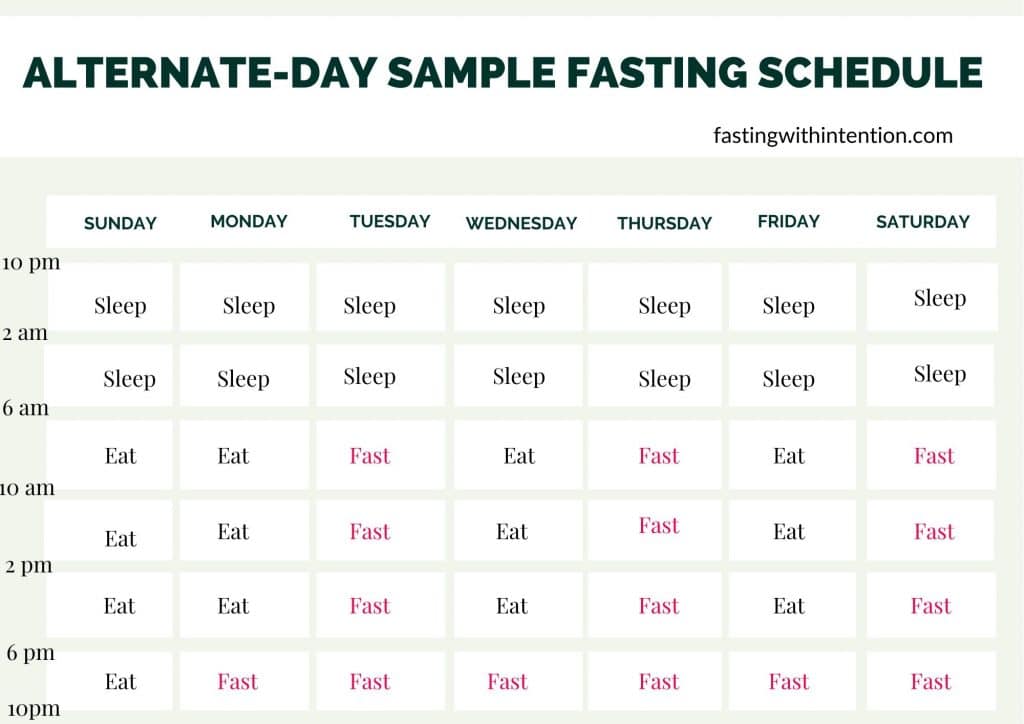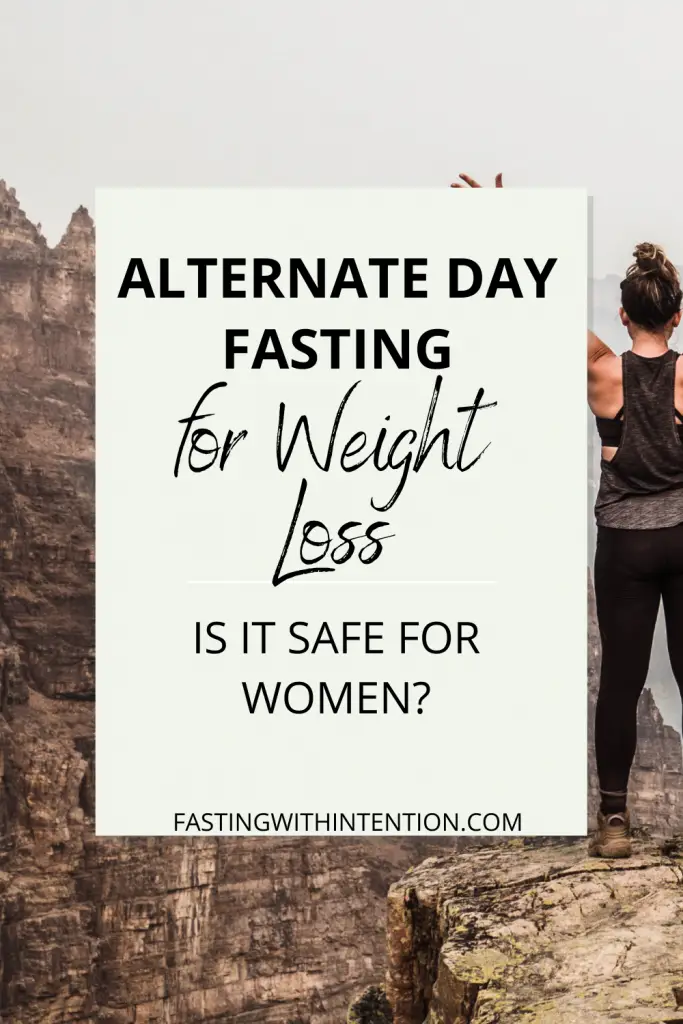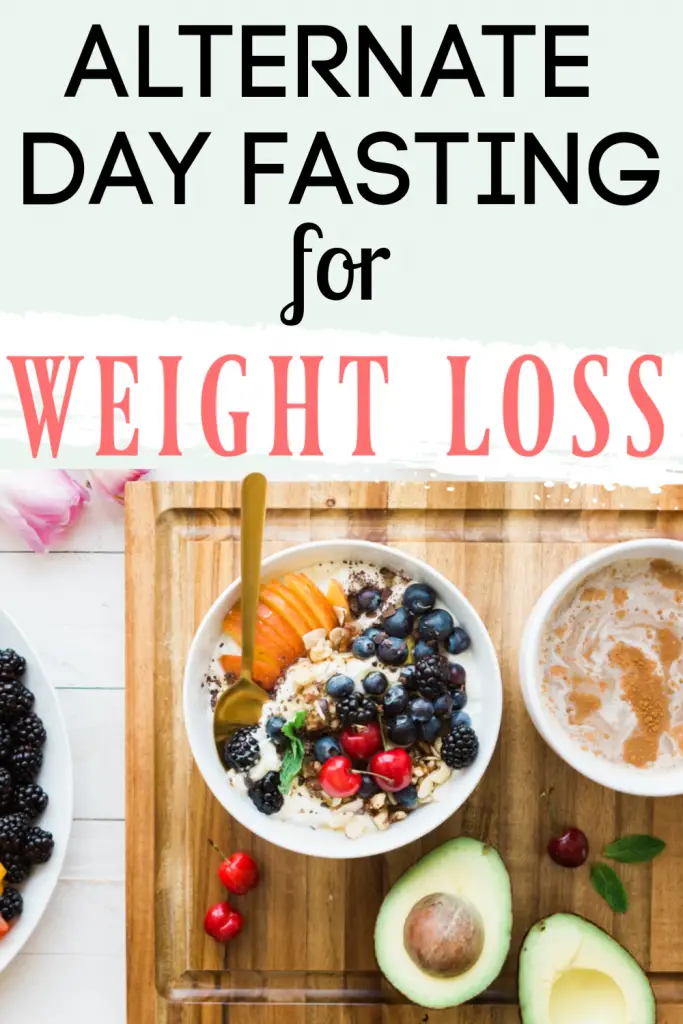In this post, I am going to explain how alternate-day fasting works and talk about whether it is safe for women. Then, I will give you an easy-to-follow alternate-day fasting schedule and give some practical ways you can start implementing alternate-day fasting for weight loss as a woman.
Alternate-Day Fasting vs. Intermittent Fasting
Alternate day fasting IS a type of intermittent fasting as you are alternating between periods of eating and periods of fasting. When I first heard about alternate-day fasting, I thought it was like crescendo fasting, which is simply fasting for 14-16 hours every second day.
However, alternate-day fasting requires you to do a longer 36-hour fast. Instead of fasting overnight and the next morning, you are fasting overnight AND the next day. It is similar to the 5:2 intermittent fasting method, which allows you to eat 500 calories during your fasting day (read my post The 5:2 Intermittent Fasting Method for Women for more info). The main differences between the 5:2 method and alternate-day fasting are:
- You are not eating at all when you are practicing the alternate-day fasting method while the 5:2 method allows you to consume about 25% your normal calorie intake (500 calories).
- The alternate-day method requires you to fast every second day while the 5:2 method is only twice a week.

Alternate-Day Fasting Benefits
If you look it up online, you will find many articles questioning the safety of alternate-day fasting. I will address these concerns, but for now, I want to talk about its benefits:
- Reduced fasting insulin levels: Your insulin levels impact your overall health in many ways. They even have an effect on your bone density and your risk of fracture.
- Weight loss: reducing your fasting insulin levels will help with weight loss, but fasting every second day will almost certainly reduce your overall calorie intake which will, in turn, help you lose weight.
- Increased ketone bodies: Fasting is beneficial to your health, no matter what type of fasting you choose. One reason for this is the fact that when you fast, your body starts using ketones for energy because glucose is not readily available. Your body will produce more ketones even on non-fasting days.
- Lowered cholesterol levels: lower cholesterol levels reduce your risk of heart disease.
- Autophagy: Autophagy is the process by which your body cleans out damaged cells. Long term and short term fasting increase autophagy. This process helps keep you younger longer.
- No decrease in your metabolic rate: Calorie restriction will decrease your resting metabolic rate. However, it seems that alternate-day fasting doesn’t cause this reduced metabolic rate. Or, rather, it causes a negligible reduction of 1% in your resting metabolic rate. By comparison, calorie restriction can reduce your resting metabolic rate by as much as 12%.

Alternate-Day Fasting Health Concerns
Intermittent fasting as a whole has been criticized because some people still think that skipping breakfast is linked with obesity (including the Mayo Clinic). Moreover, skipping meals may cause binge eating. Some say that time-restricted eating may be similar to disordered eating. If you have a history of eating disorders, it is recommended you do not practice intermittent fasting.
Alternate-Day Fasting Schedule
Here’s what an alternate day fasting schedule would look like (remember, do not implement this schedule every single week):

Basically, your alternate-day fasting schedule will require you to fast fully for 36 hours 3 times a week. The rest of the time, you may eat your regular whole-food diet. Read my Paleo 101 page for some guidance on that. If you are a woman, you may follow this alternate-day fasting schedule, but I recommend you do it only one or two weeks during the month right after your periods. For most women, it may best to not follow this schedule for the whole month. Women should avoid fasting the week before their periods. Keep reading to learn more about how fasting impacts women differently than men.

Alternate-Day Fasting and Women
As I talk about in my post Intermittent Fasting for Women: A Definitive Guide, women tend to do best with fasting approaches that allow for phasing. Phasing means you are not restricting your eating window or your calories all the time. You revert back to non-restrictive eating on a regular basis. Fasting increases your cortisol levels, which can be a good thing because it helps burn fat. However, it is possible to have too much of a good thing. For women, too much cortisol for too long can cause hormonal imbalances, adrenal fatigue, and thyroid dysfunctions. While many women thrive on daily intermittent fasting, some do not. Fasting methods that include days of regular eating may be optimal for certain women. As for me, just knowing that I don’t have to think about my eating window every single day makes me feel happier. I love the food freedom!

Intermittent Fasting and Your Reproductive Health
Women are more sensitive to hunger hormones. These hunger hormones are called leptin and ghrelin. Leptin is made by fat cells and it decreases your appetite. Ghrelin, on the other hand, increases your appetite. Estrogen may inhibit your appetite, while progesterone may increase it. It’s one of the reasons why you may feel hungrier before menstruating and why it may be better to avoid fasting during the week leading up to your periods. Furthermore, you crave more carbs during that time, and that’s ok. Listen to your body and fill up on healthy carbs like potatoes, carrots, beets, and fruits.

How Fasting Affects Women
One study on rats, which included male and female groups that practiced intermittent fasting or calorie restriction found striking differences between males and females. They found that 40% of the females became emaciated, ceased cycling, and underwent endocrine masculinization. What does that mean? Fasting could have a negative impact on women’s fertility and hormonal health. Be careful and fast safely.
How Women Can Fast Safely
Alternate-day fasting may work well for women. Just keep this in mind:
- If you feel too hungry to fast before and during your periods, eat! Listen to your body and don’t fast when you require more food.
- Practice a fasting method that allows you to resume normal eating periodically. That’s why I love the 5:2 method and the fasting mimicking diet. These two fasting methods are perfect for phasing and a non-restrictive whole food diet that still results and weight loss.
- Look for warning signs like hair loss, fatigue, low sex drive, and mood issues. If you notice any of these signs, it may be a good idea to pull back a little.
- Make sure you are getting 7-8 hours of sleep. Lack of sleep will increase your appetite and make it harder to fast.
- Eat slowly. You could set a timer for 20 minutes to make sure you take at least this much time to finish your meal. Or, consciously chew each bite 30 times before swallowing.

Alternate-Day Fasting for Weight Loss
When it comes to weight loss, intermittent fasting has many benefits. It is at least as effective as calorie restriction but doesn’t require calorie restriction and doesn’t slow down your metabolism (read more in my post Intermittent Fasting for Weight Loss). In one study that compared specifically alternate-day fasting to calorie restriction, alternate-day fasting produced a similar weight loss as calorie restriction, but it produced a greater reduction in fasting insulin levels. It’s not just about diabetes, your insulin levels impact everything in your overall health and well-being. They also regulate your appetite, which will reduce belly fat and make it easier to sustain weight loss in the long run.
Alternate-day fasting is one way to achieve your weight loss goals and regulate your insulin levels. I experienced similar benefits through the fasting mimicking diet. I have been doing the fasting mimicking diet once a month for a few months now, but the first time I did it, I immediately saw a reduction in my belly fat even though I did not sustain any weight loss. Read more in my post I went on my DIY Version of the Fasting Mimicking Diet and Here’s What Happened.
Just be aware that whatever method you choose, it has to become a lifestyle if you want to sustain weight loss. You cannot expect to maintain your weight loss if you go back to your old ways. Moreover, you do not need to go completely without food on your fasting days to see weight loss. Any calorie deficit will help you achieve your weight loss goals. If fasting completely for 36 hours sounds overwhelming, you can start with the 5:2 method. The 5:2 method is my personal favorite and it is as effective as alternate-day fasting for weight loss.

In Summary
Alternate-day fasting may be a good option for weight loss and overall health for women. However, I would recommend you implement my alternate-day fasting schedule only one or two weeks out of the month. For women, it is usually safer to fast less and longer. The fasting mimicking diet is another excellent option to start.
Alternate-Day Fasting for Weight Loss and Women Video






